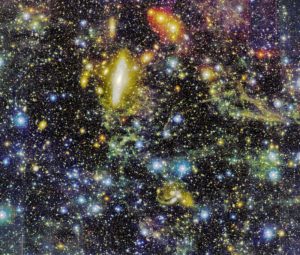CFHT Image Reveals Galactic Cannibalism in Stephan’s Quintet
New images captured by Canada-France-Hawaii Telescope (CFHT) on Maunakea are shedding light on the formation of Stephan’s Quintet, a well-known group of five colliding galaxies.
The images reveal a series of previously unseen structures including an extended red halo composed of old stars at the center of NGC 7317, an elliptical galaxy that has largely been ignored in preceding studies.
The presence of these red stars indicates the galaxy has been interacting with other members of the quintet for eons. Interactions such as these are called galactic cannibalism, which occurs when the gravitational force from a larger galaxy or group of galaxies slowly tear apart a smaller galaxy. Features in an image showing this type of phenomenon appear as streams or halos of stars orbiting the larger galaxy, like the halo of red stars seen around NGC 7317.
CFHT captured the wide-field image of Stephan’s Quintet using a 380 megapixel camera called Megacam.
“With Megacam, CFHT is at the forefront of an observing technique called low-surface brightness imaging,” said Daniel Devost, director of science at Canada-France-Hawaii Telescope. “This allows astronomers using CFHT to make discoveries like the galactic cannibalism discovery within Stephan’s Quintet.”
The quintet was named after French astronomer Édouard Stephan who first observed the group of spiral and elliptical galaxies in 1877. The group of five became famous after the Hubble Space Telescope captured an image that garnered worldwide attention in 2009.
Stephan’s Quintet is considered to be a perfect candidate for studies on the collective evolution of galaxies. Such close-knit galactic groups are subjected to a range of gravitational interactions ranging from slow collisions creating gravitational stellar streams, high-speed galactic collisions, gas ramming, starbursts and creation of intergalactic stellar systems.
The image results were published in the monthly notices of the Royal Astronomical Society by a team of astronomers from Observatoire Astronomique de Strasbourg (France), CEA Saclay (France) and the Lund Observatory (Sweden).











